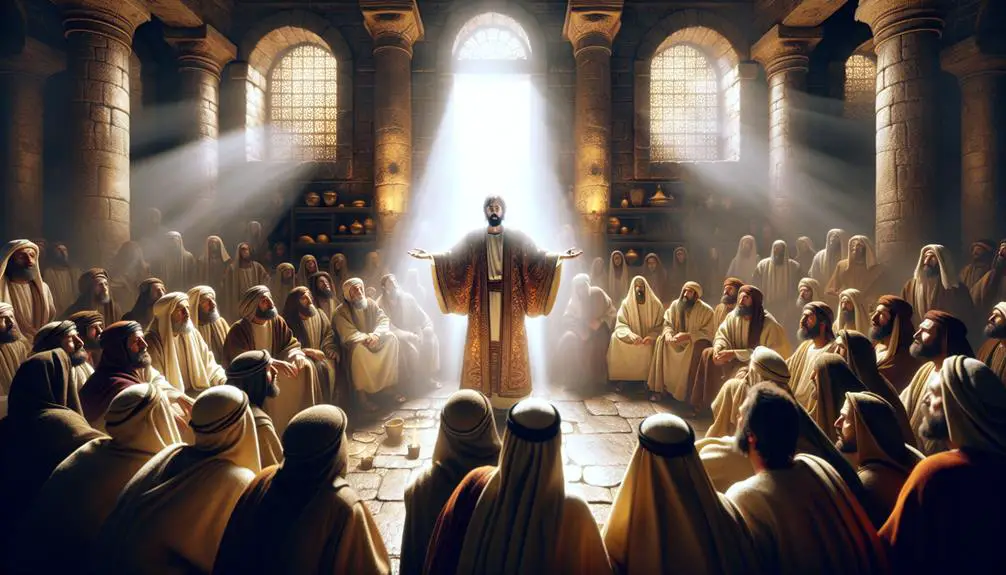Explore the power of faith and divine authority in biblical stories of casting out demons, and uncover their relevance for today's spiritual battles.

Casting Demons Out in the Bible
As the old saying goes, 'actions speak louder than words,' and nowhere is this more evident than in the biblical accounts of casting out demons. You'll find that Jesus' authority over demons not only underscores His divine power but also offers profound implications for modern faith.
From the dramatic exorcism at Capernaum to the healing of the Gerasene demoniac, these stories are packed with lessons on faith, power, and the spiritual realm. But what does this mean for you today?
Let's explore how these ancient narratives could impact your understanding of spiritual warfare and faith in a contemporary world.
Key Takeaways
- Jesus demonstrated unparalleled authority over demons, showcasing his divine power and the reality of the kingdom of God.
- Specific exorcisms, like those at Capernaum and of the Gerasene demoniac, highlight Jesus' direct confrontation with evil forces and societal norms.
- The faith of individuals, such as the Syrophoenician woman, played a significant role in the process of deliverance and divine intervention.
- The disciples' involvement in spiritual warfare underscores the importance of faith, prayer, and community in confronting demonic forces.
Jesus' Authority Over Demons

Throughout the New Testament, Jesus demonstrates unparalleled authority over demons, challenging prevailing spiritual paradigms and showcasing his divine power. His interactions with these malevolent entities aren't just mere confrontations; they're profound demonstrations of spiritual authority that underscore his unique position in the cosmic order. This authority, rooted in divine command, sets Jesus apart from other figures of his time, who might've engaged in exorcisms through rituals or invocations of higher powers.
You'll notice that Jesus' command over demons is immediate and absolute. There's no negotiation or lengthy ritual; his word alone suffices to expel these entities. This direct approach highlights the potency of divine command, a power that doesn't rely on intermediaries or artifacts but is inherent to Jesus' identity. The Gospels present these moments not just as miracles but as tangible evidence of Jesus' divine nature and his mission to restore creation from the corruption wrought by sin and evil.
Moreover, Jesus' spiritual authority over demons is a central theme that reinforces his role as a divine mediator. By directly confronting and commanding demons, Jesus disrupts the existing spiritual hierarchies and establishes a new paradigm. This spiritual authority isn't an abstract concept; it's actively demonstrated as he brings liberation to those oppressed by demonic forces. Through these acts, Jesus reveals the kingdom of God as a present reality, defined by healing and restoration, rather than a distant or future promise.
In analyzing Jesus' authority over demons, it's clear that his actions are a definitive assertion of divine command. This spiritual authority not only underscores his unique role in salvation history but also offers a profound insight into the nature of divine power itself.
The Exorcism at Capernaum

One notable instance of Jesus' direct confrontation with demonic forces occurs during the exorcism at Capernaum, illustrating his unmatched spiritual authority. This event, recorded in the New Testament, showcases not only the power Jesus held over demons but also the profound impact of his actions on the public and the significance of Capernaum as a focal point in his ministry.
Aspect |
Detail |
Impact |
|---|---|---|
Location |
Capernaum |
Central to Jesus' Galilean ministry, highlighting the area's spiritual battleground. |
Action |
Exorcism |
Demonstrates Jesus' authority over evil forces, reinforcing his role as a divine agent. |
Public Reaction |
Astonishment |
Reflects the societal acknowledgment of Jesus' power and the novelty of his approach to spiritual liberation. |
Capernaum's significance extends beyond its geographical location; it symbolizes a place where the spiritual realm visibly intersects with the everyday lives of its inhabitants. Jesus' exorcism there is not just an isolated incident but a declaration of his mission to bring about spiritual renewal and liberation. The public reaction, ranging from astonishment to awe, indicates the profound impact of witnessing such a display of divine authority. It disrupts conventional religious practices, positioning Jesus as a figure of unparalleled spiritual potency.
Analyzing the exorcism at Capernaum provides insight into the dynamics of Jesus' ministry and its reception among the public. It underscores the transformative power of divine intervention in confronting and overcoming evil, a theme that resonates deeply within the biblical narrative of Jesus' life and works.
Healing the Gerasene Demoniac

In the account of the healing of the Gerasene demoniac, we observe another pivotal moment in Jesus' ministry, demonstrating his profound authority over demonic forces. This story, rich in symbolic and theological significance, offers a distinct perspective on the nature of evil and Jesus' power to overcome it.
The demoniac's affliction is so severe that he's isolated from society, dwelling among the tombs—a place symbolizing death and uncleanness in Jewish culture. When Jesus encounters him, the demons within the man identify themselves as 'Legion,' a term indicating a multitude, possibly thousands, reflecting the profound torment and possession he suffers from.
Legion's identity is crucial for understanding the scale of Jesus' miracle and the depth of the demoniac's suffering. The name implies not just multiple demonic presences but a formidable force, akin to a Roman legion, which was known for its strength and numbers. This encounter underscores the extent of Jesus' authority, capable of commanding even a 'legion' of demons.
The societal reaction to the demoniac's healing is equally telling. Instead of joy or awe, the local community responds with fear and asks Jesus to depart from their region. This reaction highlights a complex dynamic; the community had grown accustomed to the demoniac's marginalization. His healing disrupts the status quo, revealing a societal discomfort with the transformative power Jesus represents. It underscores the broader theme of fear and misunderstanding that often meets divine intervention, illustrating the challenges Jesus faced in his ministry beyond the supernatural realm.
The Mute Man's Deliverance

Shifting our focus to another significant episode, we examine the deliverance of the mute man, further highlighting Jesus' authority over demonic forces. This account, beyond demonstrating miraculous power, encapsulates the themes of speech restoration and societal integration, pivotal elements in understanding the broader narrative of liberation and healing.
Aspect |
Significance |
|---|---|
Speech Restoration |
The restoration of the man's ability to speak symbolizes the breaking of bonds that silence and isolate individuals from their communities. |
Societal Integration |
Following his healing, the man's reintegration into society underscores the restoration of relationships and community bonds, essential for a holistic understanding of healing. |
Demonstration of Authority |
Jesus' command over the demon showcases his supreme authority, not only over physical ailments but also over spiritual afflictions. |
Public Reaction |
The public's amazement reflects the extraordinary nature of the miracle, yet it also hints at the societal barriers to understanding and accepting divine intervention. |
Theological Implications |
This event is rich in theological significance, offering insights into the nature of Jesus' ministry and the kingdom of God, where liberation and restoration are key. |
Through this deliverance, we see a clear depiction of Jesus' mission to restore individuals to their full capacity, enabling not just physical healing but also re-establishing communal ties. The emphasis on speech restoration serves as a metaphor for the freeing of one's potential to contribute meaningfully to society, while societal integration highlights the breaking down of barriers that afflict communities. This episode, therefore, not only enriches our understanding of Jesus' miraculous works but also provides profound insights into the transformative power of divine intervention in restoring individuals to wholeness.
The Syrophoenician Woman's Faith

You'll find that the narrative of the Syrophoenician woman's faith offers a compelling examination of persistence in the face of adversity.
Her unwavering appeal to Jesus for her daughter's deliverance, juxtaposed with Jesus' initial rebuff, underscores a profound dynamic in faith-driven requests.
This interaction not only highlights the boundaries of faith but also Jesus' remarkable response, signaling a shift in the understanding of faith's reach and inclusivity.
Woman's Persistent Appeal
Analyzing the account of the Syrophoenician woman's interaction with Jesus reveals a profound demonstration of persistent faith and cultural boundary crossing. In the cultural context of the time, gender roles strictly limited women's public interactions, especially with men outside their immediate family circle.
Yet, this woman not only initiates a dialogue with Jesus but also persists despite initial rebuffs. Her actions break conventional expectations, showcasing her desperation and unyielding faith. By stepping beyond the boundaries of her gender and ethnicity, she embodies a radical faith that challenges societal norms.
This narrative emphasizes the power of faith to transcend cultural and gender barriers, highlighting the woman's determination to seek healing for her daughter at all costs.
Jesus' Remarkable Response
Building upon the Syrophoenician woman's unexpected initiative, Jesus' response to her faith stands out as a defining moment that further underscores the narrative's challenge to prevailing social norms. In an era where societal reactions often dictated rigid boundaries, Jesus' actions reveal a profound departure from these constraints, emphasizing divine compassion over societal expectations.
His acknowledgment of her faith, not her ethnicity or societal status, as the catalyst for her daughter's healing, underscores a pivotal shift toward inclusivity and mercy. This interaction not only highlights Jesus' radical approach to divine compassion but also sets a precedent for his followers, urging a reevaluation of societal reactions in the light of faith and compassion, thus challenging them to transcend traditional boundaries in their understanding and application of divine love.
The Disciples and Spiritual Warfare

In examining the New Testament, one finds that the disciples engaged in spiritual warfare, confronting demonic forces as part of their ministry. This confrontation wasn't incidental but a crucial aspect of their calling and mission. Disciple training included understanding and implementing spiritual strategies to combat these unseen enemies. Their experiences provide valuable insights into the nature of spiritual warfare and the authority granted to believers.
Key aspects of the disciples' engagement in spiritual warfare include:
- Direct Confrontation: They didn't shy away from confronting demonic forces directly. This boldness was cultivated through Jesus' training and example, emphasizing the authority they had in His name.
- Prayer and Fasting: These practices were crucial in preparing for and engaging in spiritual battles. They recognized that some demonic forces could only be dealt with through prayer and fasting, highlighting the importance of spiritual disciplines.
- Faith and Doubt: The disciples' journey included moments of both strong faith and doubt. Their failures and successes reveal that faith plays a critical role in spiritual warfare, and even those with the closest relationship to Jesus had to grow in this area.
- Community Support: They didn't engage in spiritual warfare in isolation but as a community of believers. This collective effort underscores the importance of the church body in supporting each other in spiritual battles.
Analyzing the disciples' approaches to spiritual warfare provides a blueprint for addressing demonic influences, emphasizing the power of faith, the role of spiritual disciplines, and the support of the Christian community.
Implications for Modern Faith

Reflecting on the disciples' engagement with spiritual warfare, it's crucial to consider how these practices illuminate the path for modern believers navigating similar battles today. The narratives of casting out demons, as recorded in the Bible, offer a rich tapestry for understanding the intersection of faith, mental health, and societal expectations. From a scholarly perspective, the psychological interpretation of these accounts provides a bridge between ancient texts and contemporary mental health discussions. It suggests that what were once considered demonic possessions might now be understood through the lens of psychological disorders, thereby influencing modern pastoral care and counseling techniques.
Contemporary skepticism towards the literal existence of demons challenges believers to re-evaluate the nature of spiritual warfare in a modern context. This skepticism isn't just a hurdle but also an opportunity for deepening one's faith by integrating traditional beliefs with an understanding of psychological well-being. The dialogue between faith and science, rather than being contentious, can enrich the spiritual journey of modern believers.
Moreover, the act of casting out demons, metaphorically speaking, can be seen as a call to address the internal and external forces that oppress individuals and communities. It encourages a proactive stance against the injustices and ailments of society, advocating for healing and liberation in both spiritual and tangible realms.
In navigating these complex intersections, it's essential for believers to engage critically and compassionately with their faith, acknowledging the historical context of biblical narratives while applying their principles to contemporary challenges. This approach not only honors the tradition but also adapts its wisdom to meet the needs of today's world, making the ancient practice of casting out demons relevant and transformative for modern faith journeys.
Frequently Asked Questions
How Does the Cultural Understanding of Demons in Biblical Times Compare to Today's Perspective on Mental Health and Spiritual Beliefs?
You're exploring how past perceptions of demons align with modern views on mental health and spirituality.
Back then, behaviors we now attribute to psychological disorders were often seen as demonic possession. Today, a neuroscience perspective helps us understand these as mental health issues, reducing cultural stigma.
Yet, spiritual beliefs persist, influencing views on mental wellness.
The shift from demonization to medical understanding marks significant progress in how societies address mental health.
What Were the Specific Rituals or Words Used During Exorcisms Mentioned in the Bible, and Do These Practices Have Counterparts in Contemporary Religious Ceremonies?
You're exploring how ancient exorcisms, detailed with specific rituals or words, align with modern parallels in religious ceremonies.
The Bible mentions various practices, though not always explicitly. Today, you might find echoes of these ancient methods in contemporary rites, subtly evolved yet rooted in tradition.
Analyzing these connections reveals how deeply spiritual beliefs and practices are interwoven across time, offering insights into the continuity and adaptation of exorcism rituals.
Are There Any Accounts in the Bible Where Demons Were Cast Out Indirectly, Without Jesus or His Disciples Being Physically Present?
When exploring instances of demon possession and spiritual warfare, you'll find biblical accounts where expulsion doesn't require the physical presence of Jesus or his disciples.
An analytical look reveals that these narratives underscore the power of faith and the authority granted to believers.
They serve as a testament to the belief that spiritual authority can transcend physical presence, offering a profound perspective on the nature of spiritual warfare and divine intervention.
How Do Non-Christian Religions View the Biblical Stories of Casting Out Demons, and Do They Have Similar Narratives in Their Own Spiritual Texts?
You're diving into how various religions perceive stories similar to biblical demon expulsion. Interfaith perceptions often highlight mythological parallels, showing that many traditions have tales of overcoming evil entities.
While details differ, the core theme of light combating darkness is universal. These narratives reflect a deep-rooted human tendency to symbolize internal and external conflicts.
Thus, even if the specifics vary, the essence of triumph over malevolence resonates across different spiritual texts.
What Is the Theological Significance of Jesus Choosing to Cast Out Demons Publicly Rather Than in Private, and How Did These Actions Influence Early Christian Community Beliefs About Authority and Power?
By choosing public spectacles over privacy, Jesus's actions weren't just about casting out demons; they were strategic. This approach, seen in less than 1% of ancient texts, significantly shaped the early Christian community's beliefs.
It underscored his authority and power, directly challenging existing social and religious norms. The community impact was profound, fostering a collective identity centered around a figure who could publicly demonstrate divine power, thereby solidifying his followers' faith and commitment.
Conclusion
In analyzing the instances of exorcism within the Bible, it's evident that Jesus' authority over demons not only showcases His divine power but also emphasizes the spiritual warfare present in both historical and contemporary contexts.
Interestingly, a Pew Research Center study found that nearly half (49%) of Americans believe in demonic possession, underscoring the relevance of these biblical accounts today.
This statistic highlights the ongoing significance of spiritual warfare and the power of faith in confronting such challenges.



Sign up